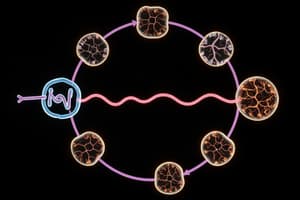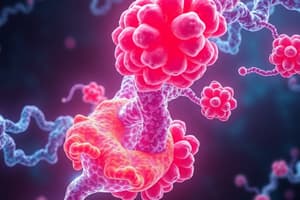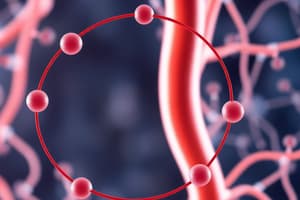Podcast
Questions and Answers
Which of the following is NOT a product of the link reaction?
Which of the following is NOT a product of the link reaction?
- Acetyl CoA
- NADH
- CO2
- ATP (correct)
The link reaction directly connects which two processes?
The link reaction directly connects which two processes?
- Citric acid cycle and the electron transport chain
- Glycolysis and the electron transport chain
- Photosynthesis and cellular respiration
- Glycolysis and the citric acid cycle (correct)
What is the primary role of NAD+ in the link reaction?
What is the primary role of NAD+ in the link reaction?
- Catalyzing the breakdown of pyruvate
- Providing energy for the reaction
- Accepting electrons and hydrogen ions during oxidation (correct)
- Transporting the acetyl group to the citric acid cycle
What is the main reason for the removal of a carbon atom from pyruvate in the first step of the link reaction?
What is the main reason for the removal of a carbon atom from pyruvate in the first step of the link reaction?
Where does the link reaction take place within the cell?
Where does the link reaction take place within the cell?
What is the primary function of coenzyme A (CoA) in the link reaction?
What is the primary function of coenzyme A (CoA) in the link reaction?
How does the link reaction contribute to ATP production?
How does the link reaction contribute to ATP production?
How can the link reaction be regulated?
How can the link reaction be regulated?
Flashcards
Link Reaction
Link Reaction
Connects glycolysis to the citric acid cycle, converting pyruvate to acetyl CoA.
Pyruvate Decarboxylation
Pyruvate Decarboxylation
The first step of the link reaction that removes a carbon from pyruvate, releasing CO2.
Acetyl CoA
Acetyl CoA
A two-carbon molecule formed from pyruvate, key for the citric acid cycle.
NAD+
NAD+
Signup and view all the flashcards
Decarboxylation
Decarboxylation
Signup and view all the flashcards
Oxidation in Link Reaction
Oxidation in Link Reaction
Signup and view all the flashcards
Link Reaction Regulation
Link Reaction Regulation
Signup and view all the flashcards
Location of Link Reaction
Location of Link Reaction
Signup and view all the flashcards
Study Notes
Overview of the Link Reaction
- The link reaction, also known as the pyruvate decarboxylation step, connects glycolysis to the citric acid cycle.
- It converts pyruvate, a three-carbon molecule, into acetyl CoA, a two-carbon molecule.
- This process occurs in the mitochondrial matrix.
Steps in the Link Reaction
- Decarboxylation: The first step involves the removal of a carbon atom from pyruvate, releasing carbon dioxide as a byproduct. This creates a two-carbon molecule called an acetyl group.
- Oxidation: The remaining two-carbon acetyl group is oxidized, meaning it loses electrons. This oxidation process involves the transfer of a pair of hydrogen atoms to NAD+ (nicotinamide adenine dinucleotide), reduced to NADH.
- CoA attachment: The acetyl group combines with coenzyme A (CoA) to form acetyl CoA. This molecule is crucial for transporting the acetyl group into the citric acid cycle.
Key Molecules Involved
- Pyruvate: A three-carbon molecule produced from glycolysis.
- Acetyl CoA: A two-carbon molecule that carries the acetyl group to the citric acid cycle.
- NAD+: A coenzyme that accepts electrons and hydrogen ions during oxidation, producing NADH.
- CO2: Carbon dioxide, a waste product of the reaction, is released into the environment.
- CoA: Coenzyme A (CoA) molecule is a carrier.
Energy Production
- The link reaction produces one molecule of NADH per pyruvate molecule, carrying high-energy electrons to the electron transport chain.
- This step generates no ATP directly. The energy stored within NADH will contribute to ATP production at a later stage (electron transport chain).
Location and Regulation
- It occurs in the mitochondrial matrix.
- The enzyme complex responsible for the process includes specific enzymes that catalyze the steps.
- The rate of the link reaction can be regulated by the availability of substrates (pyruvate) and the activity of enzymes that catalyze the reaction steps. Product inhibition of the link reaction, based on the availability/ accumulation of the products, is common.
- Higher energy charges indicate a metabolically sufficient state which can inhibit aspects of the link reaction. High NADH inhibits the link reaction to avoid excess NADH production.
Studying That Suits You
Use AI to generate personalized quizzes and flashcards to suit your learning preferences.




